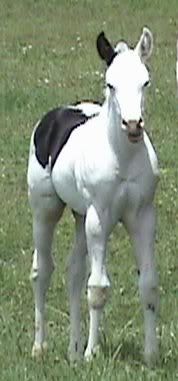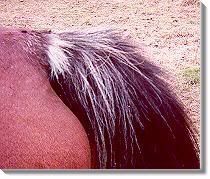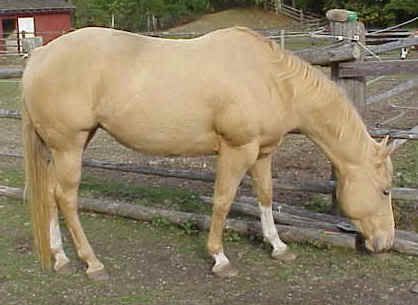A(Agouti)--A is the gene that causes bay. It only acts on a black based horse. A horse that is chestnut, or ee, will show no effects from Agouti. Now if the horse is EE or Ee (black based) and has one copy Aa or two copies AA that horse will be bay. If the horse is EE or Ee (again black based) and no copies of a (so genetically it would look like this-aa) that horse will be black. Again Agouti only effects black pigment so a chestnut horse (ee) can have one two or no copies of Agouti and the horse will still be chestnut. The only time when a chestnut horses agouti gene comes into play is when breeding. If you breed a black horse whose genes look like this EE aa (So homozygous for the black gene and no Agouti-Black horse) to a chestnut whose genes look like this ee AA (So this horse is chestnut and is homozygous for Agouti) you will always get a horse whose genes look like this Ee Aa. That foal is bay. It is black based (Ee) with one copy of Agouti, changing the black horse to bay.
Cr(Cream)--Cream is an incomplete dominate gene that only works on red based pigment. Incompletely dominant means that the effect the gene has is different when there is one copy and when there is two copies.On a black horse one copy of Cr creates a smokey black horse. This color horse is often very hard to distinguish without genetic testing because it looks exactly like a normal black horse because Cr only effects red pigment. On a black horse with two copies of cream the horse is smokey cream. This is the only time that cream effects back pigment. On a bay horse one copy of cream creates a buckskin. The cream gene only effects the red pigment on the bay so the bays mane tail legs and other black points remain black. Two copies of cream on a bay horse creates a perlino. This horses red pigment is diluted even further than one with only one copy of Cr. The black points on a perlino are also diluted. They can be diluted so much to where there is no difference between what were the black points and the body color or the points will be diluted to where the are a chocolate or brown (this is not to be confused with silver that I will cover later.) On a chestnut horse with one copy of Cr creates a palomino. The entire body of this horse including main tail and legs is all diluted. Two copies of Cr on a chestnut horse creates a cremello. This dilutes the pigment even further than a palomino does. Now the breeding aspect of Cr is this. In order for a horse to be smokey black, palomino, or buckskin at least one parent has to have at least one copy of Cr. You CANNOT get a Cr foal out of two NON Cr parents. Also to get a double dilute baby BOTH parents have to have at least one copy of Cr. You CANNOT get a double dilute foal out of one diluted parent (with one copy or two copies) and one NON dilute.
Grey-Gray is a modifying gene. The horse starts out its base color and progressivly gets whiter and whiter every year. Heterozygous grays are more likely to be fleabitten. Homozygous grays are more likely to get melanomas and vitilago. Homozygous grays also gray out quicker.
To(Tobiano)--To is the gene that causes tobiano in horses. It normally causes round smooth markings that NORMALLY do cross the back but they do not have to. Also the head is a solid color. If there is any white on the head that is a sign of another pattern. Normally sabino. A horse can either be heterozygous for Tobiano meaning one copy of the gene or homozygous for Tobiano meaning that the horse has two copies of Tobiano. No matter if it is 100% white or 0% if the horse has To the horse IS tobiano. This is why APHAs color descriptions suck-What pattern is this foal?

Frame/Lethal White Overo--If a horse has LWO the horse IS FRAME. Frame is lethal white overo, lethal white overo is frame. You cannot have one without the other. Frame horses generally have irregular patches of white that are very jagged around the edges. The normally does not cross the back, but it can. The legs are also normally solid. Any white on the leg is a sign of another pattern, again normally sabino. Frame horses normally have white markings on there head. A horse can only have one copy of this gene. If it gets two copies his intestinal track does not develope correctly and within three days of birth the horse will either die or have to be put down because of it. Frame horses are the only horses that have Lethal White. If your tobiano horse tests positive for Lethal white than your horse is frame and tobiano. It can hide very very easily and be very very minimal. If you are breeding paints you MUST test your horses to see if they have LWO. If not you risk a lethal white foal. Also if breeding to a paint stallion, ask to see the papers stating that the horse is LWO negative. A fellow posted on another board bred to a stallion she was told was negative and he wasnt. She had a LW baby. This horse (he is a miniature but it doesnt matter) is frame. He is frame because he has LWO. This is to show you just how minimal frame overo can be.
Sabino-Sabino is the gene (s) that we know the least about surprisingly. Geneticists can only test for one form of sabino. It is thought that there are many maybe even hundreds of different sabinos. It is also thought that any white on a horse not from another pattern, so white legs or face markings on horses that have no paint genes, is caused by some form of sabino. Sabino can also cause some roaning but NOT TRUE ROAN. There is also a Dominant White that is like sabino. That gene is kind of complicated so I wont get into it on here, but will in a future post.
Rabicano-Rabicano can cause what is called a "skunk tail."It is when white hairs appear on either side of the tail head like this.
 It also cause roaning on the sides of the horse, but again NOT to be confused with true roan. This is an extensively marked rabicano horse.
It also cause roaning on the sides of the horse, but again NOT to be confused with true roan. This is an extensively marked rabicano horse.  The gene for rabicano is thought to be dominant but the exact gene or genes has not been located yet.
The gene for rabicano is thought to be dominant but the exact gene or genes has not been located yet.And now my favorite Splash White-The gene has not been located yet sadly. They have been trying and trying but so far nothing. Splash can be extremely minimal just like frame. The most obvious markings of a splash white is a horse that looks like it is dipped in paint. The face is normally a big wide blaze, that gets wider at the bottom (called a bottom heavy blaze) and it normally appears to be falling off the edge of the face. Splash is also known for extremely high white stockings. Another tell tale sign of splash white, is that the bottom half of a splashed whites tail will be white. It really looks like the horse was dipped in paint. It has been proven that deafness is caused by lack of pigmentation inside the ear. Not all splash whites are deaf however it is theorized that the close the white markings on the face come to the ears the more likely it is that the horse is deaf. It is also theorized but not proven that horses that are homozygous for whatever gene causes splash will be more heavily marked. That however is all theory. (I will go into heavier detail about splash in a later post.) The foal I posted under the tobiano section is Mile High Party from Cedar Rock Farms. She is Splash White and Sabino. NO tobiano, or frame at all. Her sire is a QH and her dam is splash white and sabino, NO tobiano from either parent so no tobiano for the foal.
Rn(True Roan)-Rn is thought to be a dominant gene. If the horse has Rn he will be true roan there is no getting around that. The horses head and legs will be solid colored but everywhere else will have white roaning. This is most commonly found in Quarter Horses and Paint Horses. Thoroughbreds with true roan is a hard one. The only TBs that have True Roan are descendants from Catch a Bird. There is no known cause for why he has passed on true roan as it is not found in TBs. It was also thought that homozygous Roan is lethal however there are geneticists who believe that it is not. Also there is a line in QH (Hancock line I believe) that appear to be homozygous for roan. The common thought is that it can be homozygous lethal but it doesnt have to be, unlike Lethal White where homozygous horses are lethal.
Dun-So far there is no test for the exact dun gene. HOWEVER there is a test that is quite close. This test tests for markers that are around the gene that they believe is dun. The problem is some horses that are NOT dun HAVE these markers and some horse that ARE dun DO NOT have these markers. Dun in horses is characterized by a distinct dorsal stripe, leg and wither barring, and shading. Dun is NOT homozygous lethal. A bay horse with the dun gene becomes Dun, and red horse with the dun gene becomes Red Dun and a black horse with a dun genes becomes Grulla/o.
Z(Silver)-Silver effects black pigment. It turns black pigment a brown color. It also turns black mains and tails some shade of flaxen of white. It dilutes the black points on a bay to a mousey brown color.
Champagne-This site http://www.equinecolor.com/champagne.html Explains it much much better than I can.
Lp/Patn(Appy coloring)-This one is sightly confusing. Lp and PATN can make base colors do very weird things, such as make chestnuts look like bays, or change shades A LOT. By itself LP is only the charecteristics of Appys like mottling ect and Patn is the gene that actually causes white. But the only way Patn is expressed is if the horse has Lp. Patn without Lp is just a normal horse no appy charecteristics at all. I can go into more detail but that is the basics anything more than that and it gets confusing. PM however if you would like a more in depth explaination.
Pearl-Pearl is one of the more complicated dilution genes. By itself pearl is recessive, meaning the horse needs two copies of the gene for it to have any effect. In its homozygous form it creates the appearance of a single cream dilutes. The only time pearl acts in its heterozygous form is in association with cream. If the horse has one copy of pearl and one copy of cream it creates a fake double dilute, except it is slightly too dark and has darker skin instead of pink. This is a homozygous Pearl horse with NO cream.
 And this is a horse who is heterozygous for cream and heterozygous for pearl.
And this is a horse who is heterozygous for cream and heterozygous for pearl.
And finally Brindle-There are two causes to brindle. One is a chimera. This is when two embryos are fertilized. One ends up getting absorbed by the other, but not fully. The resulting foal ends up being two horses fused as one. The horse can have two different colors, but each color will genetically test as I different horse. The TB Catch a Bird was a chimeric brindle. He never passed his brindle on to any of his foals. His roan offspring were the product of a mutation that most likely had little to do with his chimerism. The other cause is a genetic cause. The Warmblood Natal Classi is one example of a non chimeric brindle. His owner had him tested, and it was found out that he was infact not chimeric, and is believed to have passed his coloring on to at least one offspring. The other horses that have shown to be able to pass their brindle coloring to foals are these horses http://www.geocities.com/sbatteate/brindlehos/index.htm
3 comments:
Catch A Bird was not a chimera at all, and I hadn't heard that Natal Classi was (the owner believed his foals showed brindle characteristics). Catch A Bird was a random mutation that actually resulted in the first roan Thoroughbreds (his offspring). The two confirmed chimeras are Dunbar's Gold and Sharp One, both AQHA.
LOVE your blog!! Very easy to understand and very informative. Thanks and please keep the info coming!!
FiSH's BrushFireFarms
This is my new pony's neck. He's a ConnemaraX and his mom was a solid registered paint. Is there a name for this variation?
http://menschpony.shutterfly.com/pictures/11
Thanks!
Post a Comment